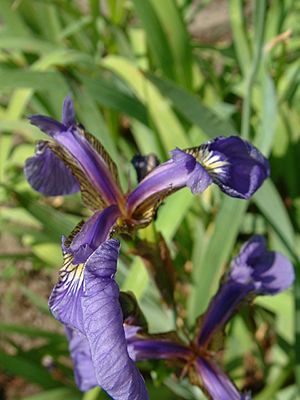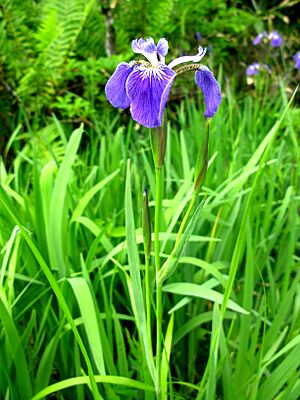Bristle-pointed iris facts for kids
Quick facts for kids Bristle-pointed iris |
|
|---|---|
 |
|
| Scientific classification | |
| Genus: |
Iris
|
| Species: |
setosa
|
| Synonyms | |
|
|
Iris setosa, also known as the bristle-pointed iris, is a type of flowering plant in the Iris family. It's a perennial plant, meaning it lives for more than two years, and it grows from rhizomes (underground stems). This iris is found across a huge area, including places like Alaska, Canada, Russia, China, Korea, and Japan. It has tall, branching stems, green leaves, and beautiful flowers that can be violet, purple-blue, blue, or lavender. Sometimes, you can even find pink or white flowers!
Contents
What Does the Bristle-Pointed Iris Look Like?
The Iris setosa plant looks a bit like a smaller version of the Japanese iris or a dwarf Iris sibirica. However, it doesn't live as long as some other iris types.
Roots and Stems
This iris has large, branching rhizomes that spread out just below the ground. These rhizomes are thick and grey-brown, covered with old leaf fibers. The plant's stems can be quite different in height, from just 10 cm (5 inches) to as tall as 1 m (3 ft). Taller plants can even grow above their leaves. Each round stem can have 1 to 3 branches.
Leaves and Flowers
The leaves of Iris setosa are a mid-green color, shaped like swords or grass blades. They can be 30–60 cm (12–24 in) long. Each stem usually has 3–4 flowers, and the whole plant can have between 6 and 13 flowers in total. They bloom in June and July.
The flowers are large, about 5–8 cm (3–6 in) wide. Their color varies depending on where they grow, from violet to different shades of blue. Very rarely, you might see pink or white ones. Like other irises, it has three large outer petals called 'falls' and three smaller inner petals called 'standards'. For Iris setosa, the standards are so tiny they look like bristles, making the flower appear to have only three petals. The falls often have dark purple veins and a yellow-white center.
How It Reproduces
This plant can fertilize itself, meaning it has both male and female parts. Insects help to pollinate it. After the flowers fade, green seed capsules form, which turn pale brown when ripe. These capsules hold small, pale brown seeds.
Scientists have studied the genetics of Iris setosa. For example, they found that most irises have two sets of chromosomes, but some Iris setosa specimens have a different number. This research helps scientists understand how different iris species are related.
How Was the Bristle-Pointed Iris Named?
This iris has many common names. In Chinese, it's called 'shan yuan wei'. In Japan, it's known as 'hiougi-ayame'.
Some common English names include 'Beachhead Iris' (because it grows near coastlines), 'Wild flag iris', 'Alaska iris', and 'Arctic Iris' (because it grows in the Arctic Circle). In the UK, it's called 'Bristle-pointed iris' because of its tiny inner petals.
The plant was first described scientifically in 1820 by Link, based on earlier notes by Pallas. It was first found in east Siberia. The RHS recognizes Iris setosa and has even given it the RHS Award of Garden Merit, which means it's a great plant for gardens.
Iris setosa is also famous in science! It was one of three iris species used by a scientist named Ronald Fisher in 1936 for an important study on how to classify living things using measurements.
Where Does the Bristle-Pointed Iris Grow?
This is the only iris species that naturally grows in both Asia and North America.
Its Wide Range
You can find Iris setosa in many places around the Arctic, including the Aleutian islands, Alaska, and Maine in the USA. It also grows in Canada (like British Columbia and Yukon), Russia (including Siberia), northeastern Asia, China (like Manchuria), Korea, and south to Japan (like Honshu and Hokkaido). In Canada, it's often found along the shores of the Gulf of St. Lawrence.
Where It Likes to Live
Iris setosa can live in many different types of environments. It grows in wet places like bogs and meadows, and next to rivers, lakes, and beaches. You can also find it on sand dunes, headlands, and in light woodlands. It can grow in sandy or gravelly soils. Even though it's often seen in wet areas, it can also do well in dry soil. It usually grows at high altitudes, between 1500–2500 m (4900–8200 ft) above sea level.
Is It Endangered?
In Japan, Iris setosa was once listed on the Red List of endangered plants, meaning it was considered critically threatened.
How to Grow Bristle-Pointed Iris
Iris setosa is a good plant for the front of a garden border. Smaller types are perfect for rock gardens or containers. It can also grow at the sunny edge of a woodland garden or in a bog garden.
This iris prefers moist or wet soils, especially during its growing season. It can adapt to different conditions, but it doesn't like heavy clay soils that dry out in summer, or soils with too much lime. It prefers partial shade, as too much sun can make the soil too dry.
When you plant the rhizomes, make sure the top of the rhizome is not covered with soil. If it's planted too deep, it might rot. In mild climates, the leaves stay green all winter. It's a good idea to trim the leaves before winter to help the plant stay healthy. New leaves will grow in the spring.
Hardiness
Iris setosa is one of the toughest iris species when it comes to cold weather. It needs a cold winter rest period, so it doesn't grow well in very warm climates. Since it's native to Alaska, it can handle extremely cold temperatures, even below freezing. It can grow in USDA Zones 3–7 or 3–8, and sometimes even in Zone 2 or 9 if conditions are just right.
How to Make More Iris Plants
You can grow more Iris setosa plants from seeds or by dividing the rhizomes.
Growing from Seed
It can be a bit tricky to grow this iris from seed, especially in some areas, because the seeds need a cold period to sprout. If you collect seeds in mid-August, you can plant them in beds or trays in a cold frame. They should be planted about 1/4 to 1/2 inch deep. If you don't plant them right away, you can freeze them for storage. In spring, when the seedlings are big enough, you can move them into individual pots. They can stay in a greenhouse or cold frame for their first year. Then, plant them in their permanent spot in late spring or early summer. It usually takes at least two years for a plant grown from seed to produce flowers.
Dividing Rhizomes
It's often easier to make new plants by dividing the rhizomes. The plant naturally spreads this way. The best time to divide them is in spring or autumn, ideally in September (about 4–6 weeks after flowering). You can divide them every year, but it's better to do it every three years, or when the plant has spread so much that the center no longer produces flowers. If you divide the plant into large sections, you can plant them right away. If you divide them into very small pieces, put them in a cold frame until the next spring so they can grow new roots.
Different Types and Hybrids
Iris setosa easily mixes with other iris species, like Siberian and Californian irises. Because of this, plant breeders often use it to create new iris types.
There are three known types of Iris setosa found in Japan:
- Iris setosa var. hondoensis: Found in Hondo, Japan, in 1930. It's about 80 cm (31 in) tall with large purple flowers. Scientists think it might be a mix with Iris laevigata.
- Iris setosa var. nasuensis: Found near Nasu, Japan. It can grow up to 1 m (3 ft) tall and has wider leaves and large flowers.
- Iris 'Shiga Ayame': This is a mix of Iris setosa and Iris sanguinea. It was found in the Shiga Highlands in Japan in 1930.
Some named types of Iris setosa that people grow include:
- 'Kosho-en' (1984) – has white flowers.
- 'Kirigamini' – has rich, velvety blue-purple flowers.
Uses of the Bristle-Pointed Iris
For centuries, some herbalists have used the rhizome (underground stem) of Iris setosa in certain medicines. However, it's very important to know that all parts of Iris setosa are poisonous. The rhizome contains a substance called iridin, which can cause allergic reactions like rashes, or upset your stomach with vomiting or diarrhea.
Even though it's poisonous, the starchy roots can be made safe to eat by cooking them thoroughly. In Japan, it's grown for its edible root. Some native groups like the Aleut also made a drink from the roots to help with digestion, but others, like the Iñupiat, considered the whole plant poisonous. In small amounts, it has been used in tinctures to help with swelling or combined with arnica as an herbal oil for bruises.
Some Inuit tribes in Alaska also roasted and ground the seeds of this iris to use as a coffee substitute. The flower petals can be used to make a violet-blue dye, and the rhizomes can be used to get a perfume that smells like violets.
Images for kids



